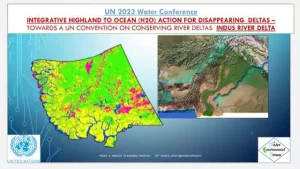UN Water Conference & Indus Delta
A side event at the UN Water Conference was held in UN headquarters New York, on the “Integrated Highland to Ocean (H2O) Action for Disappearing Deltas: Towards a UN Convention on Conserving River Deltas” which was largely successful in uniting the water organizations and professionals around the world. Amongst the partners of this event were: Africa Centre for Climate Actions and Rural Development, Transboundary Water in-Cooperation Network Vermont, Centre for Capacity Building Colorado, Water Environment Forum (WE Forum) Pakistan.
The experts and panel discussants included stakeholders from the Nigerian Niger Delta, Indus, Mekong River, Colorado, Nile and St. Lawrence transboundary river basins, each of which has various differential vulnerabilities due to accelerating sea level rise and saltwater intrusion from the oceans, and rapidly melting glaciers, increasing dams and shifting rainfall patterns in the highlands.
Conservation of inland and ocean facing deltas is critical to offset the deadly impacts of worsening climate crises and save lives of millions of vulnerable people facing these crises. Displacement of ~33 million people in Indus, and ~ 1 million people in the Niger Delta region as well as livelihood losses is a preview of what is to come without these immediate actions to build climate resilience at the global scale.

It was agreed by participants that the side event will help individual and regional governments and the United Nations (UN) to better understand the concerns of the highlands to lowlands watercourses and river deltas’ communities worldwide, to steer their interest on the need to scale-up climate ambitions, with a foreseeable UN recognition of the World’s river deltas and other low-lying coastal areas through a convention or some sort of special recognition to be called “Deltas UNITE.”
Nisar A. Memon, Chairman WEForum and former Senator talking of Indus Delta said, “Indus Delta, like all other global deltas, is severely impacted by climate change. It is the 5th largest delta in the world but the most vulnerable one. It’s River Indus flows ~3000 km from the Himalayan mountains and an estimated 300 million people are served. Moen Jo Daro – a 7000 year old civilization developed on its banks in the Sindh province of Pakistan.”
“All challenges of highland to the ocean with transboundary water sharing are experienced on this Delta, too, with not sufficient consistent flow discharging through its diminishing creeks (14 to 2), resulting in deltaic area decreasing to 92% over the last two centuries.”
“Indus Delta has the largest arid zone mangrove forest of the world, and due to the shrinking active delta, the mangrove cover is reduced with its consequent impact on the ecosystem and marine life of fish and fauna. The sea level rise, land subsidence, decreased river flows, coastal erosion, and seawater intrusion, are increasing soil salinity, and reducing the fertile agricultural area resulting in 1.2 million people migrating from Thatta and Sujawal districts to adjoining Karachi city.”
“UN, WB and Pakistan are working closely to save the Deltaic people and Loss & Damage Funding committed in Sharmal Sheikh UN Conference 2022 must be released fast.” Nisar Memon concluded by saying, “We don’t talk of challenges but solutions too and we are ready for Coastal Climate Actions based on consultation, collaboration and coordination with all stakeholders, specifically local community, and invite all to join in planned Indus Delta Consultative Workshop mid 2023.”










